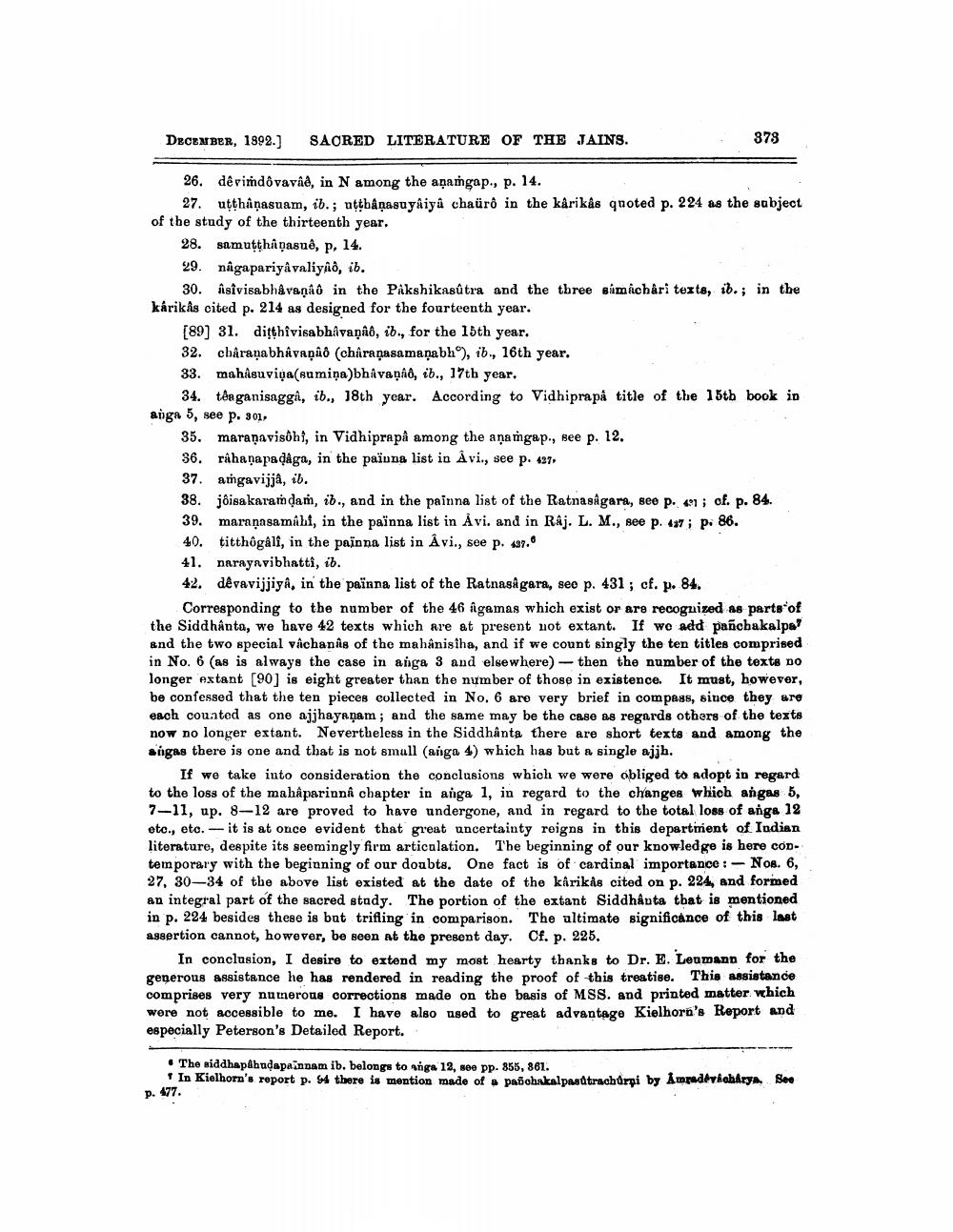________________
DECEMBER, 1892.] SACRED LITERATURE OF THE JAINS.
26. dêvimdôvavâê, in N among the anamgap., p. 14.
27. uṭṭhanasuam, ib.; utthânasuyâiyâ chaürô in the kârikâs quoted p. 224 as the subject of the study of the thirteenth year.
28. samutṭhapasuê, p, 14.
29. nagapariyâvaliyâô, ib.
30. âsîvisabhavanaô in the Pakshikasûtra and the three simichâri texte, ib.; in the kárikâs cited p. 214 as designed for the fourteenth year.
[89] 31. ditthivisabhavanâô, ib., for the 15th year.
32. châranabhavanâo (chiranasamanabh), ib., 16th year.
33. mahasuviga (sumina)bhavanao, ib., 17th year.
378
34. têaganisaggi, ib., 18th year. According to Vidhiprapa title of the 15th book in anga 5, see p. 301,
35. maranavisôhi, in Vidhiprapâ among the anamgap., see p. 12.
36. rahanapaḍaga, in the païuna list in Avi., see p. 427,
37. amgavijja, ib.
38. jôisakaramdam, ib., and in the painna list of the Ratnasagara, see p. 41; cf. p. 84. 39. maranasamahi, in the païnna list in Avi. and in Râj. L. M., see p. 427; p. 86.
40. titthôgâlî, in the païnna list in Avi., see p. 437.
41. narayavibhatti, ib.
42. dêvavijjiyâ, in the païnna list of the Ratnasagara, see p. 431; cf. p. 84.
Corresponding to the number of the 46 âgamas which exist or are recognized as parts of the Siddhanta, we have 42 texts which are at present not extant. If we add pañchakalpa and the two special vachanâs of the mahânisiha, and if we count singly the ten titles comprised in No. 6 (as is always the case in anga 3 and elsewhere) then the number of the texts no longer extant [90] is eight greater than the number of those in existence. It must, however, be confessed that the ten pieces collected in No. 6 are very brief in compass, since they are each counted as one ajjhayanam; and the same may be the case as regards others of the texts now no longer extant. Nevertheless in the Siddhânta there are short texts and among the angas there is one and that is not small (anga 4) which has but a single ajjh.
-
If we take into consideration the conclusions which we were obliged to adopt in regard to the loss of the mahaparinnâ chapter in anga 1, in regard to the changes which angas 5, 7-11, up. 8-12 are proved to have undergone, and in regard to the total loss of anga 12 etc., etc. it is at once evident that great uncertainty reigns in this department of Indian literature, despite its seemingly firm articulation. The beginning of our knowledge is here contemporary with the beginning of our doubts. One fact is of cardinal importance: Nos. 6, 27, 30-34 of the above list existed at the date of the kârikås cited on p. 224, and formed an integral part of the sacred study. The portion of the extant Siddhânta that is mentioned in p. 224 besides these is but trifling in comparison. The ultimate significance of this last assertion cannot, however, be seen at the present day. Cf. p. 225.
In conclusion, I desire to extend my most hearty thanks to Dr. E. Leumann for the generous assistance he has rendered in reading the proof of this treatise. This assistance comprises very numerous corrections made on the basis of MSS. and printed matter which were not accessible to me. I have also used to great advantage Kielhorn's Report and especially Peterson's Detailed Report.
The siddhapâhuḍapannam ib. belongs to anga 12, see pp. 355, 361.
In Kielhorn's report p. 94 there is mention made of a pañchakalpasûtrachurni by Amradévicharya. See
p. 477.




